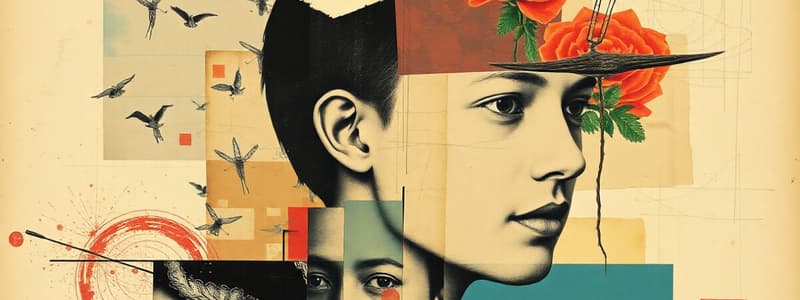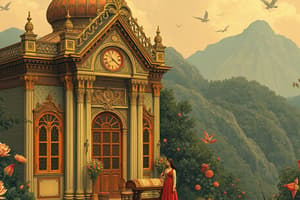Podcast
Questions and Answers
What is integrative art?
What is integrative art?
- An approach that involves creating and doing (correct)
- A form of exclusive art not related to other subjects
- A process where students listen and memorize
- A method of copying existing artwork
What is one example of an art form that reflects social change?
What is one example of an art form that reflects social change?
The 'Spolarium' of Juan Luna
Integrative art aims to involve students in a process of copying existing works.
Integrative art aims to involve students in a process of copying existing works.
False (B)
What role do students play in the art-making process according to Silverstein and Layne (2010)?
What role do students play in the art-making process according to Silverstein and Layne (2010)?
________ is defined as a continuous mark made on some surface by a moving point.
________ is defined as a continuous mark made on some surface by a moving point.
What two dimensions are lines limited to?
What two dimensions are lines limited to?
Which element creates movement within a piece of art?
Which element creates movement within a piece of art?
What does value refer to in art?
What does value refer to in art?
The term _____________ refers to three-dimensional space in art.
The term _____________ refers to three-dimensional space in art.
What is integrative art?
What is integrative art?
What does the term 'integrate' mean in the context of integrative art?
What does the term 'integrate' mean in the context of integrative art?
Integrative art only involves copying existing works.
Integrative art only involves copying existing works.
The 'Spolarium' by Juan Luna is an example of art that depicts social and political _____ in the Philippines.
The 'Spolarium' by Juan Luna is an example of art that depicts social and political _____ in the Philippines.
What role do students have in the arts according to Silverstein and Layne?
What role do students have in the arts according to Silverstein and Layne?
Which of the following is NOT one of the elements of art?
Which of the following is NOT one of the elements of art?
What is the purpose of using lines in art?
What is the purpose of using lines in art?
What does 'impasto' refer to in painting?
What does 'impasto' refer to in painting?
What dimensions are associated with the term 'form' in art?
What dimensions are associated with the term 'form' in art?
Value refers to the _____ or darkness of a color in relation to another.
Value refers to the _____ or darkness of a color in relation to another.
Flashcards are hidden until you start studying
Study Notes
Integrative Arts
- Integrative arts involve a creative process where students learn by actively creating and doing, rather than solely through listening.
- This approach facilitates collaboration, reflection, and demonstration of knowledge through various art forms, combining the arts with other subject areas.
- The term "integrative" signifies the blending of multiple knowledge types, skills, and objectives into a cohesive whole.
- Artworks, such as paintings or sculptures, can reflect social change, portraying themes derived from students' learning experiences and evolving objectives.
Historical Context of Art in the Philippines
- Philippine art has evolved from precolonial times to contemporary forms, showcasing Filipino identity and culture.
- Indigenous art and that influenced by colonizers contributed to the current understanding of contemporary Filipino art.
- The "Spolarium" by Juan Luna serves as an example of an artwork reflecting social and political meanings.
Arts and Education Connection
- Arts education positions students as active meaning-makers and encourages them to reflect on and interpret their learning through art.
- Students are expected to develop the ability to create original works, revise them, and conceptualize ideas that express their understanding.
Elements of Art
- Line: Defined as a continuous mark made on a surface by a moving point; guides viewer's eye through compositions.
- Shape: Creates movement and contributes to the overall design; can be flat and two-dimensional, limited to length and width.
- Form: Encompasses three-dimensional aspects that add depth to a piece.
- Texture: Affects the perceived feel or appearance of objects within the artwork; techniques like "impasto" add actual texture to painted surfaces.
- Value: Refers to the lightness or darkness of colors, which helps establish contrast and depth within a composition.
Artistic Techniques
- José Joya is noted for using bold colors and multiple techniques, such as layering and impasto, to create dynamic visual experiences in his paintings.
Integrative Arts
- Integrative arts involve a creative process where students learn by actively creating and doing, rather than solely through listening.
- This approach facilitates collaboration, reflection, and demonstration of knowledge through various art forms, combining the arts with other subject areas.
- The term "integrative" signifies the blending of multiple knowledge types, skills, and objectives into a cohesive whole.
- Artworks, such as paintings or sculptures, can reflect social change, portraying themes derived from students' learning experiences and evolving objectives.
Historical Context of Art in the Philippines
- Philippine art has evolved from precolonial times to contemporary forms, showcasing Filipino identity and culture.
- Indigenous art and that influenced by colonizers contributed to the current understanding of contemporary Filipino art.
- The "Spolarium" by Juan Luna serves as an example of an artwork reflecting social and political meanings.
Arts and Education Connection
- Arts education positions students as active meaning-makers and encourages them to reflect on and interpret their learning through art.
- Students are expected to develop the ability to create original works, revise them, and conceptualize ideas that express their understanding.
Elements of Art
- Line: Defined as a continuous mark made on a surface by a moving point; guides viewer's eye through compositions.
- Shape: Creates movement and contributes to the overall design; can be flat and two-dimensional, limited to length and width.
- Form: Encompasses three-dimensional aspects that add depth to a piece.
- Texture: Affects the perceived feel or appearance of objects within the artwork; techniques like "impasto" add actual texture to painted surfaces.
- Value: Refers to the lightness or darkness of colors, which helps establish contrast and depth within a composition.
Artistic Techniques
- José Joya is noted for using bold colors and multiple techniques, such as layering and impasto, to create dynamic visual experiences in his paintings.
Studying That Suits You
Use AI to generate personalized quizzes and flashcards to suit your learning preferences.




